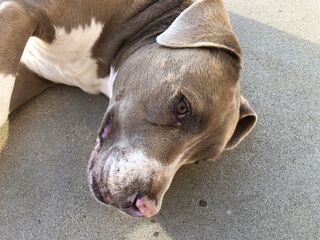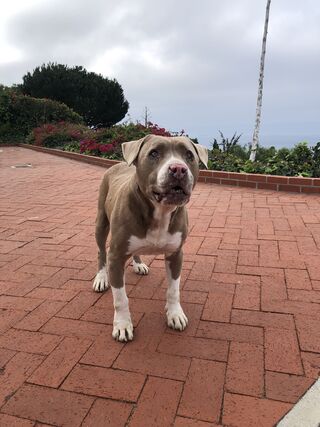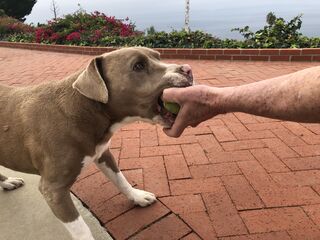Here’s a reverse aging tool I learned from my neighbors’ dog.

My next-door neighbors said to me last week, “You brought our dog back to life,” which touched me deeply. You may think that because I am a physician, I applied my medical skills to their dog, but this is not what happened.
What happened is much deeper than that. It links reverse aging and happiness to the neighbor’s dog.
It all started in April 2021 when a new family of five (or should I say a family of six) moved next door to us. That family consisted of a young mother, a young father, their three young kids, and… a 13-year-old, brown-and-white, female pit bull.

Because there was no fence between our two properties, I told the family that Georgia (the dog) was welcome to roam in our backyard as she wished. The family’s answer was: “Georgia is a very old dog; she has trouble walking, and she probably won’t go very far off our property.” Georgia indeed looked very old, walked slowly, and seemed to be uninterested in life.
As months went by and occasional wild rabbits came to visit our backyard, Georgia decided to patrol our backyard every morning and every night, staying 10 minutes or so, then going back to her property.

Everybody who knows me knows that I love dogs. Being interested in Georgia’s personality, I started testing her. Did she like to be petted? Did she like to play? What kind of toys did she like? I had old tennis balls in my garage and decided to take one out to see if Georgia was interested.
Georgia’s reaction was immediate. Not only was she interested in the tennis ball, but she was also hypnotized by it. As I threw the ball in front of Georgia, she ran to get it and brought it back to me, wanting more.
The second time she got it, she came back limping. Her right front leg seemed to be hurting. Yet, she still wanted to play. Not wanting to tire her too much, I put the tennis ball in the house and gave Georgia a belly rub, transporting her to a state of absolute delight.
I had found two activities that Georgia seemed to really love: running after a tennis ball and belly rubs.
As months went by, Georgia became able to run more and more.
This last month, Georgia has been coming to our backyard almost every morning and sometimes twice a day, looking through the sliding glass doors to see if my husband and I are there and ready to play, then running after her tennis ball over and over again, playing catch, then playing keep-away, making my husband and I run after her to get the ball with what seems an absolute joy for her (and for us).

Then, anticipating her belly rub, Georgia has been ending up lying on her back, looking at us with what seems to be a big smile. It has been a delight to witness the transformation of old Georgia into the young puppy Georgia she probably used to be.
As my husband and I watched Georgia’s transformation, we reflected on how this kind of transformation can apply to humans.
Can play also reverse aging in humans?
In other words, can the association of passion for play and physical exercise get humans to feel and be younger?
I did some research:
- For passion, Canadian research, published in the International Journal of Aging and Human Development, shows that engagement in passionate activities via their influence on positive affect is associated with an increase in subjective well-being and might be beneficial for older adults.
- For playfulness, research done by Careen Yarnal and colleagues from Pennsylvania State University and published in the American Journal of Play studied the relationship between healthy aging and playfulness and created an Older Adult Playfulness scale identifying 15 older adult qualities that indicate playfulness: happy, optimistic, cheerful, joyful, positive, relaxed, enthusiastic, mischievous, naughty, clowning, teasing, creative, whimsical, funny, humorous.
- For physical exercise, in a study published in 2021 in Frontiers in Genetics, Sellami and colleagues show that aerobic exercise training and/or endurance training appears the most effective in conserving intact chromosomes without the chromosome shortening associated with aging in general. Also, for older adults, moderate-intensity resistance training appears beneficial to maintain normal chromosome length.
- In addition, research done by Texas Tech University shows that physical exercise can create neurogenesis, which means that our brain can, as we grow into older age, create new neuronal synapses (the connections between brain cells) and even grow new brain cells.
So, let’s find our passion in life, do more physical exercise, and play more to age less, just as Georgia did, the neighbors’ dog who taught me so much.
Because, as playwright George Bernard Shaw said:
“We don’t stop playing because we grow old, we grow old because we stop playing.”
References
https://files.eric.ed.gov/fulltext/EJ985548.pdf
https://www.ncbi.nlm.nih.gov/pmc/articles/PMC8379006/
https://jamanetwork.com/journals/jamainternalmedicine/fullarticle/27729…
https://journals.sagepub.com/doi/abs/10.2190/AG.66.3.b
https://www.health.harvard.edu/mind-and-mood/can-you-grow-new-brain-cel…
https://citeseerx.ist.psu.edu/viewdoc/download?doi=10.1.1.464.7574&rep=…
